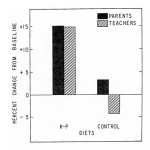This gallery contains 1 photo.
Pediatrics, 1976 Aug;58(2):154-66. In a double-blind crossover study, 15 children were given a control diet and the “K-P” (Feingold) diet eliminating artificial flavors, colors, and natural salicylates. QUOTE: “Both parents and teachers reported fewer hyperkinetic symptoms on the K-P diet … Continue reading

























